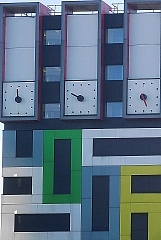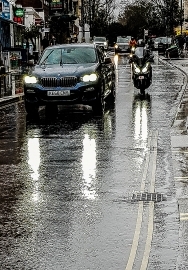Adam Yamey's Blog: YAMEY, page 134
February 23, 2022
A guiding light near Brighton
THE RIVER ADUR rises in Sussex and flows through the county, reaching the sea (the English Channel) west of Brighton and Hove at Shoreham-by-Sea. Facing the rivers opening to the sea and close to the Brighton Road (A259), there stands the slender, tall Shoreham Lighthouse. The stone lintel over the small, narrow door at the base of the lighthouse bears the date “A.D. 1846”.
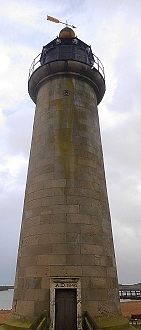 Shoreham lighthouse
Shoreham lighthouseThe lighthouse was built in 1842 and was at first supplied with oil lamps (https://brightonmuseums.org.uk/discover/2011/08/26/shoreham-lighthouse/). The structure was first used in 1846, the date on the lintel. In the 1880s, the lighting system was modernised, and the new lamps were powered by gas. It was only inn 1952 that the gas-powered system was replaced by electric lights (http://shoreham.adur.org.uk/lighthouse.htm). Major repair work was carried out in 1985-86, and the lighthouse is still in service, its beams can be seen from up to 15 miles away.
The tower, about 39 feet high, is made from blocks of limestone. The lamp housing topped with a weathervane mounted on a perforated, spherical base. It was rotating very keenly when I saw it on the second day of Storm Eunice (20th of February 2022). The weathervane is above the lamp housing that has and polygonal roof. At each corner of this, there a metal sculpture depicting the head of a fish with its mouth open.
The lighthouse stands facing a largely industrial stretch of the coast and a row of unexceptional looking two-storey residential buildings. This part of the coast is a complete contrast to the grand (and quite as grand) buildings lining the seafront at Hove and Brighton.
The lighthouse stands a few yards away from the new lifeboat station, built in 2010. It was so wet and windy when I stepped out of the car to take some photographs that I did not linger long. However, I noticed many hardy individuals setting out boldly to stride along the shingle beach despite the horrible weather.
February 22, 2022
Time to time
February 21, 2022
The Apple of my eye in Regent Street
LONG BEFORE IT became the Apple Store on Regent Street in central London, I used to look at the colourful mosaics on its building’s façade. Running in a line along the top of the mosaics, which are above the four arches of the shopfront, are the names of several cities including St Petersburg. This used to intrigue me a lot in the years before Communist rule ended in Russia and the city was then called Leningrad.
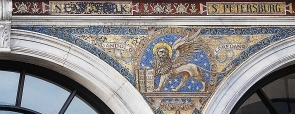
The mosaics contain depictions of several coats-of-arms including and two lions, each resting a paw on an object. One of the lions has wings and rests its paw on an open book on whose pages are the words: “PAX TIBI MARCE ENVANGELISTA MEUS”. For, this creature is the lion of St Mark, symbol of Venice and its former empire. On both sides of the lion, there are depictions of streamers. One reads “DANDOLO” and the other “LOREDANO”. Both are the names of important patrician families in Venice. Two other crests also appear, one on each side of the winged lion and the two names. One is for the island of Murano and the other for the island of Burano. These two islands in the Lagoon of Venice, especially Murano, are known for their glassmaking activity.
The mosaics were originally installed when the Venetian glass-making company Salviati opened its store in this building, designed by GD Martin, on Regents Street in 1898. The business made both fine glassware and mosaics. Soon after the firm was founded in 1859, it began to be established in England. According to a company history (www.salviati.com/en/our-story/):
“It was also in London, on 21st December 1866, that the “Società Anonima per Azioni Salviati & C.” was established with the support of diplomat Sir Austen Henry Layard and historian William Drake.”
Fortunately, the lovely mosaic has survived and has been kept in good condition. I have always marvelled at it when wandering along Regent Street, but I wonder how many people rushing into Apple’s attractive looking shop notice it.
February 20, 2022
At Liberty in London
BEFORE WE MARRIED in 1993, many of our kind friends wanted to give us wedding presents. A large proportion of them wanted to choose gifts from a ‘wedding list’. For those who are unfamiliar with this kind of list, let me explain. A ‘wedding list’ is a list of items, usually available from a shop chosen by the bride and groom, from which those wishing to give wedding presents can choose. As the items are bought, the shop removes them from the list so that the likelihood of duplicate purchases is reduced.
We were a little reluctant at first, but people insisted that it would be helpful if we compiled a wedding list. We chose to have our list at a shop that we both enjoy visiting: Liberty on Great Marlborough Street, very close to Regent Street.
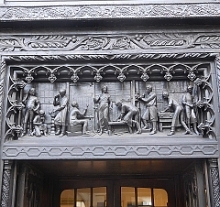 Above an entrance to Liberty shop
Above an entrance to Liberty shopFrom the outside, Liberty looks like an extremely well-preserved example of Tudor architecture, too good to be true. It is not because it was completed in 1924.
Liberty was founded by Arthur Lasenby Liberty (1843-1917), son of a draper. In 1875, he opened his own shop on Regent Street. According to the Liberty website (www.libertylondon.com), he wanted:
“… a London emporium laden with luxuries and fabrics from distant lands, his dream was to metaphorically dock a ship in the city streets. To this day, a voyage of discovery awaits on the good ship Liberty, with history hidden amongst six floors of cutting-edge design, unexpected edits and beautiful wares from the world’s greatest craftspeople. In 1875, Arthur borrowed £2,000 from his future father-in-law and took a building on Regent Street, London with just three dedicated staff and plenty of ambition.”
By the time that Liberty opened his shop, the British public was fascinated by Japan and other parts of Asia. In 1885, he brought 42 villagers from India and set up a temporary ‘living village’ of artisans in the shop.
The website added:
“Liberty’s collection of ornaments, fabric and objets d’art from around the world proved irresistible to a society intoxicated at the time by Japan and the East and Liberty effected social change in interior design and dress, so much so that the Art Nouveau period in Italy is called ‘Liberty Style’.”
Liberty died before his new shop was completed. Designed by Edwin T Hall and his son Edwin S Hall, it was built in the Tudor Revival style that achieved great popularity in the 1920s. Not only is the shop’s exterior in the Tudor Revival style, but also its interior. A great dela of wood was used in the construction as the shop’s website revealed:
“… the builders Messrs Higgs & Hill were given a lump sum of £198,000 to construct it, which they did from the timbers of two ancient ‘three-decker’ battle ships. Records show more than 24,000 cubic feet of ships timbers were used including their decks now being the shop flooring: The HMS Impregnable – built from 3040 100-year-old oaks from the New Forest – and the HMS Hindustan, which measured the length and height of our Liberty building.”
Even if you do not wish to purchase anything from our long out-of-date wedding list, a visit to Liberty is rewarding not only to see the wonderful range of beautiful products on sale but also to narvel at the building and its many finely crafted decorative features.
February 19, 2022
Two historic hotels by the sea
MOST OF SOUTHEND in Essex was built after the Victorian era. The town on the estuary of the River Thames was and still is the nearest seaside resort to London. According to “Encyclopaedia Britannica”, Southend:
“…became fashionable as a seaside resort when visited by Princess Charlotte of Wales in 1801 and by her mother, Princess Caroline (wife of George IV), in 1803.”
Originally, Prittlewell, once a village north of Southend but now one of its suburbs, was the only settlement in the area now occupied by the modern town of Southend. South east of it on the coast was a tiny village called Leigh, which is now the much larger Leigh-on-Sea. The resort now known as Southend-on-Sea was developed at the end of the 18th century in Prittlewell’s southern district of South End. Today, more than seven miles of buildings extend from Leigh-on-Sea through Southend to Shoeburyness.
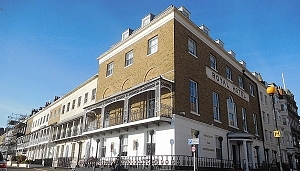
The High Street, part of a road heading south from Prittlewell, runs from near Southend Victoria Station towards the sea, ending at the edge of a steep slope that falls to the seashore below. Various roads and a lift can be used to descend this incline. At the top of the slope, the High Street meets the eastern end of Royal Terrace. At the corner where these two streets meet, stands the Royal Hotel. Next to the hotel and lining Royal terrace, numbers 1 to 15 were built in the 1790s at the same time as the hotel. These were backed by the Royal Mews, a road still in existence. These constructions were part of a then new phase of development of the town, which was known as ‘New Town’.
The hotel, a fine Georgian edifice, opened with a grand ball in 1793. Princess Caroline House that adjoins the hotel. number 1 the High Street, is a listed building, which looks as if it is contemporary with the hotel. The gardens on the slope in front of the hotel and the Terrace are known as The Shrubbery and were originally for the exclusive use of residents in the Terrace, but now they are open to the public. According to www.southend.gov.uk/historic-southend/history-southend/2:
“The Terrace was named “Royal” following visits by Princess Caroline, wife of the Prince Regent, in 1803 and for a short time attracted fashionable society. But difficult access from London by road and river discouraged further development until the construction of the railway in 1856. Royal Terrace is the only surviving Georgian terrace in Southend.”
Just east of the High Street and dominating the shoreline is the massive Park Inn Palace hotel, formerly the The Metropole. Built in 1901, this hotel that looks like an oversized liner had 200 rooms, a billiard room, and a splendid ballroom. During WW1, it was temporarily used as a Royal Naval Hospital. An online article (http://beyondthepoint.co.uk/first-world-war-southend-the-palace-hotel/) related:
“The Palace Hotel was built in 1901 and served great use in the war effort. Messrs Tolhurst; the owners of the hotel, were generous enough to offer the building up for free as a naval hospital for the rest of the war. Its glorious five star interior would’ve been quite bizarre with hospital beds placed amongst its lounges and ballrooms. It held possibly the world’s first purpose-made x-ray department. It recently underwent refurbishment by Park Inn to bring it back to its former glory.”
Both hotels overlook both the sea and Southend Pier. The older, Royal Hotel, is less of a blot on the landscape than the Palace hotel.
February 18, 2022
Headlights in the rain
February 17, 2022
A great art gallery near the sea
UNTIL WE WENT to Southend (in Essex) in February 2022, it was not the first place to spring to mind when thinking about art galleries. To my mind, Southend was mainly associated with its spectacular pier, which is over one mile in length. Now, to the pier I will add the Beecroft Art Gallery to the good reasons for visiting Southend.
The gallery has been housed in a distinctive 20th century building on Victoria Avenue since 2014. Its current home was formerly Southend’s Central Library. The edifice was designed by Borough Architect R Horwell and opened in 1974. Prior to moving there, the gallery was housed in a large Edwardian house on Station Road in nearby Westcliffe-on-Sea.
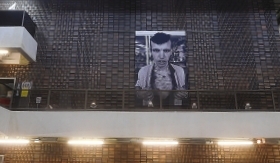
The permanent collection of art in the gallery was donated to the town in 1952 by a local collector, a solicitor called Walter Beecroft, who worked in Leigh-on-Sea. His paintings ranged from the 17th century to the late 19th, and a few from the 20th. A selection of these was on display in the first-floor gallery of the Beecroft when we visited. Newer additions, mainly on long-term loan, to the gallery’s collection were hung alongside examples donated by Beecroft.
We went to the Beecroft to see a temporary exhibition of 20th century artists from London’s East End. It was excellently curated. I will write about this in the future. There were also temporary exhibitions of Pakistani wedding outfits and feminism during the covid19 lockdown. The basement of the Beecroft is currently dedicated to the history of jazz.
All in all, the Beecroft Gallery is well worth visiting. The quality of the exhibitions we saw there puts to shame a few of the better-known art galleries in London.
February 16, 2022
A bridge, canals, and a church in west London
THE GRAND UNION canal meets the River Thames at Brentford. From there, it runs towards the Midlands where it meets other waterways in England’s extensive network of canals, which was built for commerce, but is now used mainly for pleasure.
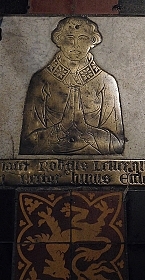
Six miles along the canal from Brentford, there is an important junction. Here at Bulls Bridge, the Paddington Arm branches off the main Grand Union canal. From beneath the bridge, the Arm runs 13 ½ miles to Paddington. Near its destination in central London, the arm flows through a large body of water, known as Little Venice. From there, two canals, the continuation of the Arm and the Regents Canal, link Little Venice to Paddington Basin and Limehouse Basin respectively.
The Paddington Arm was opened for use in 1801. The Bulls Bridge is a single-arch brick bridge spanning the Paddington Arm a few feet east of its junction with the Grand Union Canal. It stands amidst a dull landscape filled with industrial units and large supermarkets.
Following the towpath along the Grand Union Canal away from Bulls Bridge in a north-westerly direction for 177 yards, we reach a bridge that carries the canal over a narrow stream, the River Crane. a tributary of the River Thames. According to a website, touristlink.com, the course of the Crane is as follows:
“The River Crane is 8.5 miles (13.6 km) in length. Its source is taken to be a point south of North Hyde Road in Hayes, Hillingdon, from where its course is generally in a southerly, if near semi-circular, direction, before it joins the River Thames at Isleworth. Its name is a back-formation from Cranford, London. Formerly it was called the Cranford River. The River Crane creates the boundary between the London boroughs of Hillingdon and Hounslow.”
What could be seen from the bridge carrying the canal over the Crane was a deep weed-filled fissure in the depths of which there was a narrow stream. This lies in the shadow of an elevated road, the busy Parkway (A 312) that links both the A40 and the M4 with Heathrow Airport.
Continuing north-west along the Grand Union, the canal passes beneath a series of railway bridges that carry trains to and from Paddington Station. Nearby is Hayes and Harlington station, which stands in a part of Hayes, which was once the village of Botwell. This is now a shopping area with supplied with lavishly stocked fruit and vegetable shops and a branch of Lidl’s supermarket chain. Lidl’s faces a Roman Catholic Church, Immaculate Heart of Mary, built in 1961, which according to Pevsner, contains a painting by Pietro Annigoni (1910-1988). Near the station is a less attractive church, St Anselm, built between 1926 and 1928.
Even at the beginning of the 20th century, Hayes in Middlesex was a village north of Botwell and separated from it and other neighbouring settlements by open countryside. By 1940, Hayes had begun to be engulfed by London’s western spread. The village was, according to James Thorne, writing in 1876:
“… quiet and respectable, and chiefly dependent on the wealthy residents … consists of a few ordinary houses and shops.
Today, it is still quiet, the commercial district being in Hayes Town, the former Botwell, near the railway station.
There is one good reason to visit what was old Hayes. That is to see the parish church of St Mary the Virgin. It stands on the eastern side of Barra Hall Park, which are the grounds of the former manor house, now much modified. The church is mediaeval. Its lychgate is probably early 16th century. Its chancel is late 13th century, the tower and the north aisle are 15th century, and the main aisle is 16th century. The church has beautiful timber ceilings and a 12th century font. On the north wall there is a large wall painting of St Christopher carrying the Christ child. Pevsner did not consider this image was painted before about 1500.
The church is full of fine funerary monuments. These include elaborate memorials for Sir Walter Grene (1456); the judge of the King’s Bench Edward Fenner (died 1612); Roger Jenyns (died 1693) and members of his family; Richard Lugg (1697); and Thomas (died 1576) and Elizabeth Higate. There are plenty more monuments to be seen as well as several fine brasses. Fenner’s monument consists of an effigy of Fenner lying recumbent supporting his head on his right hand. This is framed by marbled pillars supporting an elaborate carved stone semi-circular canopy, which is flanked by a pair of sculpted figures.
Although Hayes is not high on most tourist’s lists of what to see in London, the old church parish church of Hayes is certainly worth a detour. As for Bulls Bridge, visiting it is only for dedicated enthusiasts of desolate landscapes and inland waterway history.
February 15, 2022
Out to sea without stepping off land
THE FIRST TIME I visited Southend in Essex was in about 1960. I was invited to go there on a day trip with my best friend, his younger brother, and their father, who was a senior official in London Transport. We went by car, stopping on the way at several London Transport bus garages, where we saw a few vintage busses. I remember two things about Southend on that first visit. First, we ate fish and chips. It was the first time I had sampled this cuisine because my parents were too snobbish about food to have been seen dead in a fish and chip shop. I have enjoyed fish and chips ever since that time in Southend. The other thing that sticks in my mind was travelling along Southend Pier in a special train that carried passengers almost to its furthest point from the seafront. It was not until the 11th of February 2022 that I made my second visit to Southend.
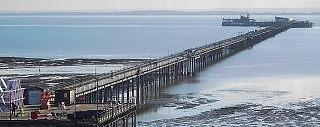 Southend Pier
Southend PierSouthend Pier is the longest pleasure pier in the world. It is 1.34 miles (2.16 kilometres) in length. The present pier, which replaced an earlier wooden one built in the early 1830s, was completed in the late 1880s. it was opened to the public in 1889. At about this time, the single-track railway running along it was also ready for use. It was extended by 1898. The trains were then electrically operated. In 1978, the electric railway was closed. By 1986, it had been re-opened using trains that were driven by diesel engines. It was on one of these that we took a return trip this February.
I enjoy piers. They provide a way of going out to sea without leaving land and without risking seasickness. In addition, like the one at Southend, most of the piers in England are visually satisfying when viewed from the shore. At the sea end of Southend Pier, there are various structures ranging from painted wooden shacks to the beautiful contemporary-style Royal Pavilion, opened in 2012. Despite being a complete contrast to the other constructions on the end of the pier, it enhances to visual attractiveness of the area.
Although the pier was not the primary reason for our excursion to Southend, it certainly enhanced our enhancement of the place as did our lunch at a local fish and chips shop.
Out to sea without stepping of land
THE FIRST TIME I visited Southend in Essex was in about 1960. I was invited to go there on a day trip with my best friend, his younger brother, and their father, who was a senior official in London Transport. We went by car, stopping on the way at several London Transport bus garages, where we saw a few vintage busses. I remember two things about Southend on that first visit. First, we ate fish and chips. It was the first time I had sampled this cuisine because my parents were too snobbish about food to have been seen dead in a fish and chip shop. I have enjoyed fish and chips ever since that time in Southend. The other thing that sticks in my mind was travelling along Southend Pier in a special train that carried passengers almost to its furthest point from the seafront. It was not until the 11th of February 2022 that I made my second visit to Southend.
 Southend Pier
Southend PierSouthend Pier is the longest pleasure pier in the world. It is 1.34 miles (2.16 kilometres) in length. The present pier, which replaced an earlier wooden one built in the early 1830s, was completed in the late 1880s. it was opened to the public in 1889. At about this time, the single-track railway running along it was also ready for use. It was extended by 1898. The trains were then electrically operated. In 1978, the electric railway was closed. By 1986, it had been re-opened using trains that were driven by diesel engines. It was on one of these that we took a return trip this February.
I enjoy piers. They provide a way of going out to sea without leaving land and without risking seasickness. In addition, like the one at Southend, most of the piers in England are visually satisfying when viewed from the shore. At the sea end of Southend Pier, there are various structures ranging from painted wooden shacks to the beautiful contemporary-style Royal Pavilion, opened in 2012. Despite being a complete contrast to the other constructions on the end of the pier, it enhances to visual attractiveness of the area.
Although the pier was not the primary reason for our excursion to Southend, it certainly enhanced our enhancement of the place as did our lunch at a local fish and chips shop.

